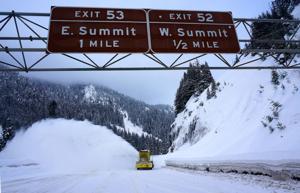UPDATE: Washington State has just announced a groundbreaking upgrade to its avalanche control measures at Snoqualmie Pass, eliminating the use of artillery for the first time in decades. The new remote-controlled system, funded by a $1 million state appropriation, aims to enhance safety and efficiency on the critical roadway that sees over 28,000 vehicles daily.
The Washington State Department of Transportation (WSDOT) confirmed that the innovative system includes six solar-powered remote-controlled avalanche control towers, which will safely trigger controlled avalanches above Interstate 90. The pass typically receives an astounding 450 inches of snow each year, making avalanche control essential for maintaining safe travel conditions.
Previously, WSDOT relied on artillery, including a World War II-era Howitzer and an M60 tank, to manage avalanche risks. This outdated method not only posed safety hazards for crews but also required lengthy preparations, often taking up to six hours before the first shot could be fired. According to transportation spokesperson Tina Werner, the new system dramatically reduces road closures, potentially limiting them to just 30 minutes to 2 hours after an avalanche is triggered.
“This is a safer, more effective system than what we were previously using,” Werner stated. “Now we’ll be able to force an avalanche in a controlled environment, potentially miles away.” John Stimberis, avalanche control supervisor for Snoqualmie Pass, echoed this sentiment, emphasizing the improved safety for crews who previously worked dangerously close to explosive artillery.
The transition to this modern technology aligns Washington with other states like Colorado and California, enhancing its reputation for proactive avalanche safety measures. WSDOT has been working towards this upgrade for several years, as the old systems became increasingly inefficient, culminating in the retirement of the tank in 2018 after it reached the end of its usable life.
The new technology not only promises a longer lifespan—expected to last at least 30 years—but also a significant reduction in the time and effort needed for avalanche control. The agency reports that the remote-controlled system can be set up in minutes, allowing for rapid deployment during adverse weather conditions.
As winter approaches and snowfall increases, this upgrade is crucial for ensuring the safety of travelers on Snoqualmie Pass. The change marks a pivotal moment in the state’s approach to avalanche management, showcasing a commitment to modernizing infrastructure for the safety of its citizens.
Residents and travelers alike can expect smoother travel conditions as this system goes into operation, marking a new era in avalanche control at one of Washington’s busiest mountain passes. Stay tuned for further updates as WSDOT implements this state-of-the-art system.







